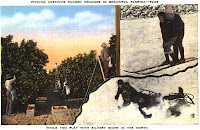 |
By Jane Feehan
Winterhurst, Fort Lauderdale’s first ice rink had a short run
in the mid-1960s. Its most enduring legacy, perhaps, was interest in the
feasibility of Florida ice hockey.
Ohioans Doris and John Nolan announced in September 1962
that ground was to be broken for an ice skating facility at 2829 North Federal
Highway (today site of a Tesla showroom and service center). They brought 12 years
of experience operating ice rinks in their home state and had raised $575,000
for their Fort Lauderdale project.
The 16,000-sf space would house an 85 ft by 185 ft ice rink
with seating for about 800. A snack bar, lockers, rental skates, blade
sharpening and sports shop to sell skates would also be available. A lot went
into construction of that ice rink: 10 miles of pipe encased in concrete and 120
tons of refrigeration. Sepper Construction built the facility with a
standard size ice hockey rink, and refrigeration experts Ahrendt Engineering oversaw rink construction.
It seemed like a good idea. The Viking, an ice-skating arena/restaurant
and cocktail lounge had opened with some fanfare that summer in Dania Beach
with Don Granger as president. The Nolan’s project had the support of Fort
Lauderdale Mayor Cy Young who was enthusiastic about adding to Fort Lauderdale’s
tourist attractions.
Winterhurst opened February 8, 1963. An opening attraction,
the Zamboni, “a mechanical marvel,” cleared and polished skating surfaces (versions
still operate today). Weekly advertisements for the rink announced a seven-day
morning and night schedule for individual skating and figure skating clubs.
By October that year, sponsors such as Cars-A-Popin and Anaconda Realty rallied to organize the South Florida Hockey Association; it was headed by Steve Craig. The association introduced their teams (based on age divisions), players and the sport to Fort Lauderdale on October 28, 1963—the first competitive ice hockey game in Fort Lauderdale. (Ice hockey was already a thing in Miami by the early 1960s.)
Winterhurst hockey tickets, according to advertisements, were a $1.10, including tax. The association organizers hoped to see a “full-fledged professional hockey league” in South Florida. They also envisioned Fort Lauderdale as “one of the world’s sports centers.”
Whether spurred by the high cost of operating or low
attendance, the Nolans began transitioning Winterhurst to a teen dance center in 1965. They wanted to take a couple of months off to melt the ice and open the doors
to teens for part of the year. Fort Lauderdale
teacher David McKinley partnered with the Ohio couple to oversee a place for local
kids to go. Winterhurst could host as many as 3,000 dancing teens and
already had a powerful sound system.
By June 1965, the place was opened to large teen dances, a
hootenanny with square dancing and pool tables (a note from parents was
required to play) and pinball machines. The arena was also the site for band auditions
and charity flea market sales. The first dance drew 500 teens; about 1,350
attended the second dance. Competition may have come from the Armory where teen
dances had been held for three years by 1965. There were also teen dances at the War
Memorial Auditorium during those years.
Winterhurst patrons were locked out in October 1965 by the building’s
landlord. (Some history is missing here because first news accounts indicated
the Nolans owned the building.) The couple said they had not paid rent for two
months while ice melted at the rink. Another
hangout for teens, Code 1, followed the Winterhurst occupancy. The Nolans moved
on to manage the Orleans Inn in Pompano.
And ice hockey? Is this a back-to-the future tale about the Florida Panthers? Not exactly. But it does point to the keen interest locals and new residents have held in the sport since the 1960s.
The missing ingredient was money. That arrived with billionaire Wayne Huizenga. He founded the Florida Panthers in 1993 after the National Hockey League granted him an expansion franchise.
The
Florida Panthers played in Miami until 1998 until they moved to Broward County to play at
the FLA live Arena in Sunrise.The Florida Panthers, still on the move, will open a
training facility at the War Memorial in late 2023. Skating will be open to the
public as well as restaurants and other amenities.
A full circle tale …
Sources:
Photo of skates: https://commons.wikimedia.org/wiki/File:Tubeskate.jpg (D
Fort Lauderdale News, Sept. 29, 1962
Fort Lauderdale News, Jan. 25, 1963
Fort Lauderdale News, Feb. 26, 1963
Fort Lauderdale News, Oct. 17, 1963
Fort Lauderdale News Nov. 3, 1963
Fort Lauderdale News, Jan. 23, 1964
Fort Lauderdale News, April
3, 1964
Fort Lauderdale News, June 2, 1965
Fort Lauderdale News, June 11, 1965
Fort Lauderdale News, Oct. 15, 1965
Fort Lauderdale News, July 22, 1966
Fort Lauderdale News, Feb. 18, 1967
https://www.flapanthersvault.com/panthers-history-highlights/
https://www.ftlwarmemorial.com/home-2023
Tags: first competitive ice hockey game in Fort Lauderdale, Fort Lauderdale history, Fort Lauderdale ice skating, Florida Panthers






















